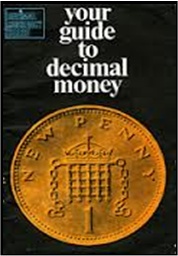 292 - Mr P. Kerswell
292 - Mr P. KerswellCycle Dealer Mr Kerswell was a notable and long established Bristol cycle dealer who was based in Lawrence Hill. However in the mid 1960s Percy Kerswell's shop found itself in the Lawrence Hill Redevelopment Zone. Consequently in 1966 it was acquired for demolition to make way for the building of the Lawrence Hill roundabout. Mr. Kerswell moved to 292 Church Road, which was opposite the Park Cinema. What stands out for some local people is that they recall Mr. Kerswell refused to 'go decimal'. Decimalisation was a significant issue for shopkeepers and the general public in the period 1968-1971.
For some people, the move to decimal money was a big worry. Perhaps not surprisingly, many elderly people were highly suspicious of the new-fangled system.
('Old' money: In the Victorian age and until 1971, the pound was made up of 20 shillings. Each shilling (5p) was worth 12 old pennies, and 'coppers' included the penny, half-penny and farthing. A crown was worth five shillings and a half-crown 2/6d.) |
 In the early 1960s, Macmillan's Conservative Government had started investigating the process of adopting the decimal currency system. Harold Wilson took forward the proposal as part of the whole 'Modernising Britain' theme. In 1966 the Chancellor of the Exchequer, James Callaghan, confirmed that the new decimal currency would use the traditional name 'penny' and not 'cent'. In preparation for the new system, the first decimal coins (10 new pence and 5 new pence) hit the high streets of Britain in April 1968. One year later the 50p coin was introduced. Decimalisation finally happened on 15th February 1971, on Edward Heath's watch.
In the early 1960s, Macmillan's Conservative Government had started investigating the process of adopting the decimal currency system. Harold Wilson took forward the proposal as part of the whole 'Modernising Britain' theme. In 1966 the Chancellor of the Exchequer, James Callaghan, confirmed that the new decimal currency would use the traditional name 'penny' and not 'cent'. In preparation for the new system, the first decimal coins (10 new pence and 5 new pence) hit the high streets of Britain in April 1968. One year later the 50p coin was introduced. Decimalisation finally happened on 15th February 1971, on Edward Heath's watch.
 The government mobilised a massive publicity campaign to educate the nation about the new 'D-Day' - Decimal Day. At the end of the process the government thanked the public and business community for a smooth transition to the new system.
The government mobilised a massive publicity campaign to educate the nation about the new 'D-Day' - Decimal Day. At the end of the process the government thanked the public and business community for a smooth transition to the new system.